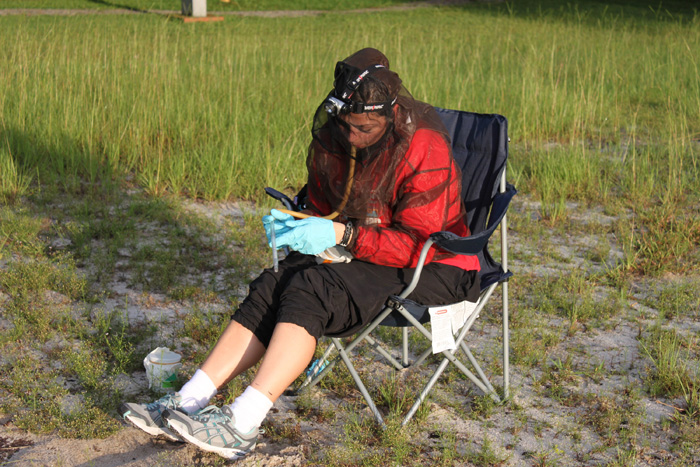Keeping the 'Bugs' at Bay

The U.S. Army Medical Materiel Development Activity collaborated with the Walter Reed Army Institute of Research together with industry partners to offer service members a safe and effective DEET-free insect repellent alternative.
The integrated team conducted laboratory and field testing to evaluate four spray and lotion repellent formulations with non-DEET (N,N-diethyl-meta-toluamide) active ingredients. Upon presenting results to DoD's Armed Forces Pest Management Board, the team successfully obtained a National Stock Number for Natrapel®, a non-DEET alternative.
Depending on where you are in the world, an insect bite can simply be an annoyance or it can lead to a life-threatening disease. Service members and travelers are at a much higher risk of contracting life-threatening and life-altering diseases, such as malaria, dengue and leishmaniasis, from biting insects.
While DEET is a proven safe and effective insect repellent that has been protecting service members since the late 1940's, some people dislike the feel and odor of the ingredient.
"The importance of having an alternative available to DEET is to improve compliance of DoD personnel wearing repellents when in areas where they are at risk of disease from biting insects," said Dr. Kendra Lawrence, senior scientific consultant for the Pharmaceutical Systems Project Management office at USAMMDA. "Those who are happy with DEET will continue using it, while those who aren't will have a choice and they may be more inclined to reach for that choice and protect themselves."
Natrapel® is a pump spray topical repellent with 20 percent Picaridin, a synthetic compound derived from the same plant family as the table seasoning black pepper. Developed in 1998, Picaridin has been a top-rated and widely used active ingredient in Europe and Australia, making its debut in the United States in 2005.
In 2006, researchers at WRAIR began to evaluate Natrapel® and other non-DEET repellents as possible alternatives to Ultrathon™, the military's standard, DEET-based repellent since 1990.
"Although Ultrathon™ is a highly efficacious repellent, we had anecdotal evidence that many soldiers were not using it, citing a greasy feel, pungent odor or unfounded claims of toxicity," says John Paul Benante, an investigator for the Entomology Branch at WRAIR. "We wanted to provide soldiers with a DEET-free alternative repellent that also offered excellent protection."
In 2010, this research transitioned to USAMMDA for advanced development and field testing.
"We tested several candidate repellents against insects from regions all over the world... i.e. North and Central Africa, Southeast Asia, South America and the United States." said Lawrence. "It's important to evaluate the effectiveness of these repellents against different insect species and in field conditions if possible, especially those that are significant disease vectors."
The four candidate products, including Natrapel®, are registered with the Environmental Protection Agency and their two active ingredients are recommended by either the World Health Organization or the Centers for Disease Control and Prevention.
Although the safety of the products was already established, the team knew that additional testing was needed to satisfy specific military requirements before making the product available to service members.
The team assessed each product's shelf-life, whether it could withstand dramatic changes in climate, and if it could alter a service member's near infrared signature. User acceptability was especially important to evaluate because the most effective repellent is useless if service members fail to apply it.
The USAMRMC Test Branch completed a packaging durability evaluation. Containers were subjected to drop testing, vibration testing and exposed to extreme temperature shocks to make sure they would hold up in a tough military environment.
The International Center for Orthopaedic Advancement, Johns Hopkins University-Bayview Medical Center conducted mechanical and interface testing to evaluate the impact each repellent had on both the strength and visual appearance of interfacing materials. Completed tests provided data on the impact of repellents on the strength, stiffness, light transmissibility and the degree to which clear plastics were "fogged" once exposed to the repellent.
Natrapel® is now available to all service members for purchase under the NSN 6840-01-619-4795. Additionally, Natrapel® is commercially available to everyone at many department and sporting goods stores.














